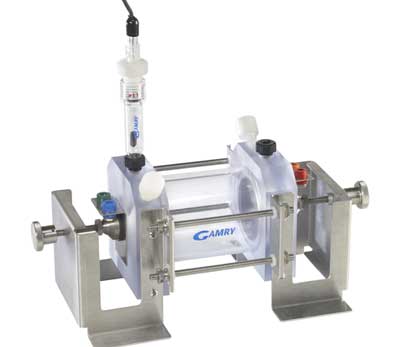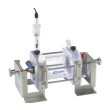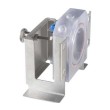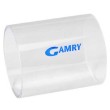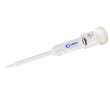Overview
The ParaCell™ Electrochemical Cell Kit (Part No. 992-80) operates with 300 mL electrolyte. Aside from the two endplates for working and counter electrode mounting, there are four other ports. In the normal cell configuration, setup is as follows:
- End plate with Blue/Green jacks: flat specimen (working electrode)
- End plate with Red/Orange jacks: 2nd flat specimen or counter electrode (graphite plate)
- Top #7 Ace-Thread of working electrode end plate for a Luggin capillary/bridge tube for use with Gamry’s SCE, Ag/AgCl, and Hg/Hg2SO4 reference electrodes (electrodes ordered separately)
- Three remaining #7 Ace-Threads which can be used for reagent addition, bubbling/blanketing/venting, et cetera
The cell body is chemically-resistant polycarbonate and all metal is 304 Stainless Steel. The two end brackets are isolated from each other with plastic bushings so that contact with the samples will not short the electrodes mounted in the ParaCell™ . Take care not to short the two ends by leaving the ParaCell™ in, for example, spilled electrolyte.
The central hole on each end plate exposes a nominal area of 2.85 cm2 where the working electrode and counter or second working are exposed. The Paracell™ employs a PTFE-Encapsulated Silicone O-Ring to define the sample area. To discourage crevice corrosion, a potential problem with any flat sample, the 1 cm2 Portholes™ Electrochemical Sample Masks can be used with the ParaCell™.
The top holes also have a small vent hole to the top of the cell for pressure release when bubbling when nearly full.
The reference electrode bridge tube is a vertical tube. This eliminates the annoying problem of a trapped air bubble in a thin, horizontal tube that plagues other flat cell designs. A low-impedance porous glass frit is used to establish electrical contact with the electrolyte.
The electrode connectors are color-coded to match the color scheme of the cell cables for Gamry Potentiostats.
Recommended Uses
Galvanic Corrosion
When running galvanic corrosion experiments with the ParaCell™ two different metals are clamped into the two ends. One sample becomes the working electrode with Work (green) and Work Sense (blue) leads connected, and the other becomes the counter electrode with Counter (red) and Counter Sense (orange) leads connected. It does not matter which material is working and which counter, the current direction will let you know which is more active and which is more noble (positive current = working active, negative current = working noble).
A reference electrode is optional in this setup, but if desired the reference can be inserted on either side. In general it will be setup on the working electrode side.
Electrochemical Noise
Electrochemical noise is very similar in setup to galvanic corrosion, only the same material is used for both working and counter electrodes. Electrochemical noise is a more powerful and more complex technique.
Corrosion of Flat Specimens
Corrosion testing of flat specimens (DC and AC—EIS/EFM—experiments) works well with the ParaCell™ Electrochemical Cell Kit. The setup differs from the above in a couple ways. First the counter electrode should be an inert material (the graphite plate that comes standard is good), and the counter sense need not be attached, though it does not cause a problem to leave it. Second the reference must be clipped in, preferably to a reference electrode in the reference bridge tube on the working electrode side. The bridge tube should be positioned with the porous glass frit centered on the working electrode.
Masking the working electrode surface to reduce crevice corrosion is a good idea, particularly for samples more inclined to pitting. Note that very low corrosion rate materials will have very low currents; since the ParaCell™ only exposes a maximum of 2.85 cm2, it may be preferable to use a configuration that will allow more exposed area.
Coated Samples
Coated samples covers a wide range of interests: corrosion, physical electrochemistry, materials science. Any conducting or semi-conducting sample will work well. Insulating samples become a problem as the thickness increases. Barrier coatings with very low capacitance (i.e. thick samples) produce very small signals, and, similar to the low corrosion rate materials, a larger exposed area may be preferred.
For coated samples the setup will be very similar to that for measuring corrosion unless the coating is on an insulating backing (like glass). The end plate connections for the ParaCell™ require the sample to be conductive to that plate. If the sample is coated on a glass or other insulating substrate, then electrical contact will need to be made another way. Leaving enough sample out so that it can be clipped to, or affixing a wire that can lead around are two possible solutions.


